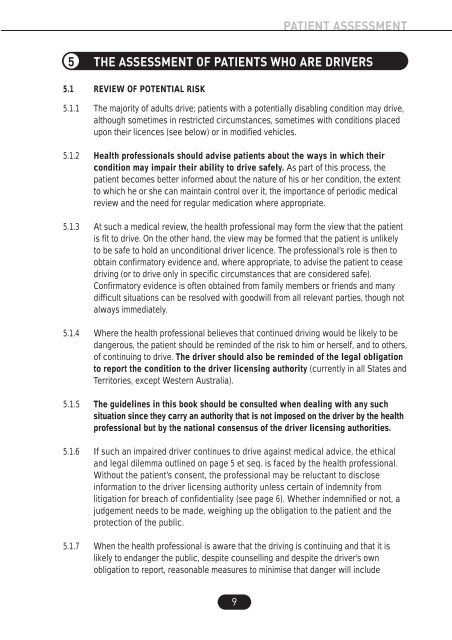Assessing Fitness to Drive - BiOptic Driving Network
Assessing Fitness to Drive - BiOptic Driving Network
Assessing Fitness to Drive - BiOptic Driving Network
- No tags were found...
Create successful ePaper yourself
Turn your PDF publications into a flip-book with our unique Google optimized e-Paper software.
PATIENT ASSESSMENT5 THE ASSESSMENT OF PATIENTS WHO ARE DRIVERS5.1 REVIEW OF POTENTIAL RISK5.1.1 The majority of adults drive; patients with a potentially disabling condition may drive,although sometimes in restricted circumstances, sometimes with conditions placedupon their licences (see below) or in modified vehicles.5.1.2 Health professionals should advise patients about the ways in which theircondition may impair their ability <strong>to</strong> drive safely. As part of this process, thepatient becomes better informed about the nature of his or her condition, the extent<strong>to</strong> which he or she can maintain control over it, the importance of periodic medicalreview and the need for regular medication where appropriate.5.1.3 At such a medical review, the health professional may form the view that the patientis fit <strong>to</strong> drive. On the other hand, the view may be formed that the patient is unlikely<strong>to</strong> be safe <strong>to</strong> hold an unconditional driver licence. The professional’s role is then <strong>to</strong>obtain confirma<strong>to</strong>ry evidence and, where appropriate, <strong>to</strong> advise the patient <strong>to</strong> ceasedriving (or <strong>to</strong> drive only in specific circumstances that are considered safe).Confirma<strong>to</strong>ry evidence is often obtained from family members or friends and manydifficult situations can be resolved with goodwill from all relevant parties, though notalways immediately.5.1.4 Where the health professional believes that continued driving would be likely <strong>to</strong> bedangerous, the patient should be reminded of the risk <strong>to</strong> him or herself, and <strong>to</strong> others,of continuing <strong>to</strong> drive. The driver should also be reminded of the legal obligation<strong>to</strong> report the condition <strong>to</strong> the driver licensing authority (currently in all States andTerri<strong>to</strong>ries, except Western Australia).5.1.5 The guidelines in this book should be consulted when dealing with any suchsituation since they carry an authority that is not imposed on the driver by the healthprofessional but by the national consensus of the driver licensing authorities.5.1.6 If such an impaired driver continues <strong>to</strong> drive against medical advice, the ethicaland legal dilemma outlined on page 5 et seq. is faced by the health professional.Without the patient’s consent, the professional may be reluctant <strong>to</strong> discloseinformation <strong>to</strong> the driver licensing authority unless certain of indemnity fromlitigation for breach of confidentiality (see page 6). Whether indemnified or not, ajudgement needs <strong>to</strong> be made, weighing up the obligation <strong>to</strong> the patient and theprotection of the public.5.1.7 When the health professional is aware that the driving is continuing and that it islikely <strong>to</strong> endanger the public, despite counselling and despite the driver’s ownobligation <strong>to</strong> report, reasonable measures <strong>to</strong> minimise that danger will include9


